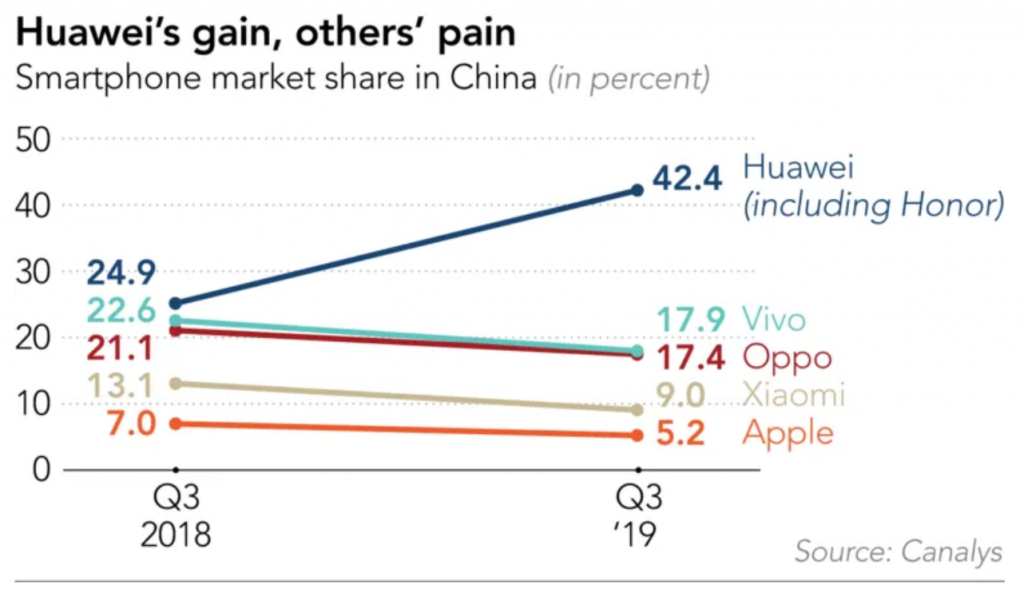Washington’s decision to block Huawei smartphones from using Google’s mobile services has created some unexpected victims: By forcing the company to retreat from abroad, it has squeezed rival Chinese smartphone makers and reinforced Huawei’s already dominant market position at home.
The latest sign of distress came late last month when Xiaomi, the fourth-largest smartphone vendor in China, announced its fifth management reshuffle this year. The shake-up comes after the Hong Kong-listed company in November reported its first quarterly decline in smartphone revenue since going public in July 2018.
Analysts say Xiaomi alone is not to blame for its shrinking sales; the slump is also collateral damage from the US’s de facto export ban against Huawei.
“With no access to Google mobile services, Huawei now has to focus its sales on China,” where Google has been banned for years and locals have embraced alternatives, said Flora Tang, an analyst at global consultancy Counterpoint Research in Hong Kong.
“The US ban also has increased the sense of nationalism, which works in favor of Huawei,” Tang said. “Many Chinese pledged that they would only purchase Huawei phones.”
The intensified competition, combined with rising consumer support for Huawei, has created “huge pressures” on other smartphone vendors in the country, and homegrown brands like Xiaomi are no exception, Tang said.
During the July-September quarter, Beijing-based Xiaomi sold 8.6 million handsets in China, down 38% from the same period last year, according to Counterpoint Research.
Nicole Peng, vice president of mobility at market intelligence firm Canalys in Hong Kong, also attributed Xiaomi’s falling sales in part to the ripple effect of Huawei’s overseas retreat.
“If Huawei wants to maintain its overall growth, it will have to ramp up domestic sales to offset its overseas slowdown,” Peng said. However, in a market where total handset shipments shrank by 3% in the July-September period from a year earlier, one company’s gain is another company’s loss. Statistics from Canalys show that Vivo and Oppo, the country’s second- and third-largest smartphone vendors, have also taken a hit since the Huawei ban.
Dongguan-based Vivo held just 17.9% of the Chinese market in the third quarter, compared with 22.6% in the same period last year. Meanwhile, the market share of Oppo, also based in Dongguan, fell to 17.4% from 21.1%, and Xiaomi’s market share slid to 9% from 13.1%.
By contrast, Huawei’s market share surged to 42.4% from 24.9%, almost equivalent to Xiaomi, Oppo and Vivo combined.

Apple, the only foreign brand that remains on China’s top five smartphone vendor list, has also lost its shine for Chinese shoppers. Its market share fell to 5.2% in the third quarter from 7% last year.
“The next few months will mark an even tougher time for Xiaomi and other smartphone vendors in China,” Peng said.
In October, the country’s three mobile carriers launched long-awaited 5G service plans. “Huawei is in a strong position to consolidate its dominance further in the Chinese smartphone market through 5G rollouts,” Peng said.
The Shenzhen-based telecom giant is currently the only Chinese smartphone vendor that can produce 5G chipsets on its own, making it easier for Huawei to control production costs and sell next-generation handsets at consumer-friendly prices.
Huawei’s increased attention to the domestic market began in May after Washington added the company to the so-called Entity List, which requires U.S. suppliers to gain a license before exporting their components or services to Huawei. Google’s compliance with the U.S. government’s blacklisting of Huawei is expected to hold back Huawei’s overseas expansion, as shoppers outside China view applications like Google Maps and Gmail as necessities in their digital life.
When Huawei introduced its latest Mate 30 smartphone series in September, it was the first time the company launched a premium handset without specifying its availability overseas. Nearly three months later, Huawei has yet to kick off full-scale international sales, although it has announced sales of limited supplies in Spain and Singapore.
Xiaomi and others are scrambling to fill the vacuum created abroad. Xiaomi is set to enter Japan on Monday, ahead of its original schedule of next year. In Europe and Southeast Asia, where Huawei’s smartphone presence has started to soften, Xiaomi and its two peers, Vivo and Oppo, have also beefed up their operations. Oppo recently opened its first flagship store in Bangkok, with more stores planned in Malaysia, Indonesia, Vietnam, and the Philippines.
“Since they cannot fight Huawei at home, they will likely seek growth abroad,” Peng said of the three Chinese smartphone vendors.
But even overseas growth may be too little to turn the tide, at least immediately. During the July-September quarter, Xiaomi sold RMB 32.3 billion (USD 4.6 billion) worth of smartphones worldwide, down 7.8% from the same period last year, its financial filings show.
The smartphone maker raised USD 4.7 billion in its stock market debut in Hong Kong last year, making it one of the biggest initial public offerings in the world for 2018. This year, its shares have fallen by nearly a quarter.
This article first appeared on Nikkei Asian Review. It’s republished here as part of 36Kr’s ongoing partnership with Nikkei. 36Kr is KrASIA’s parent company.
